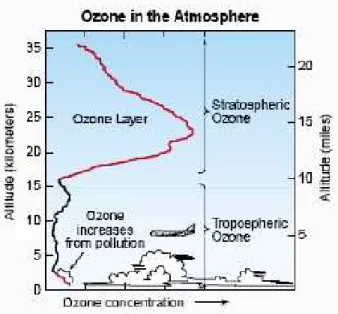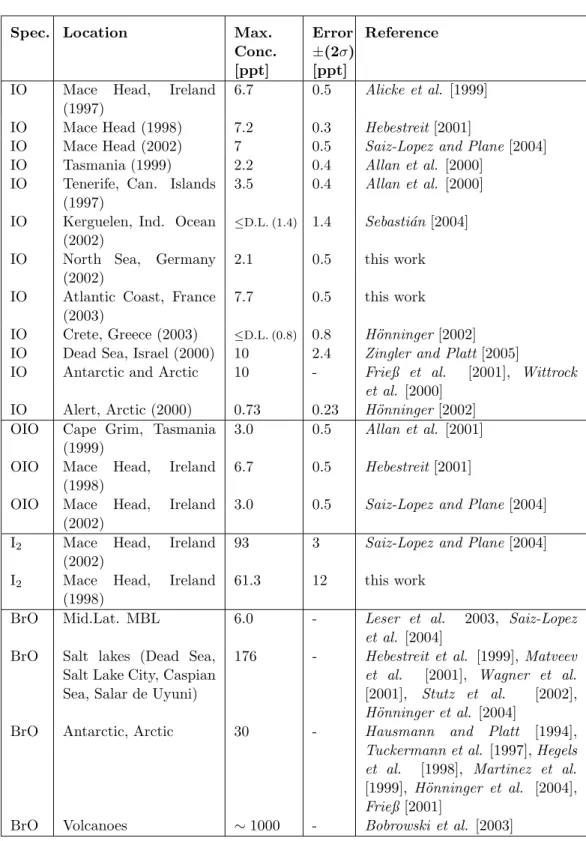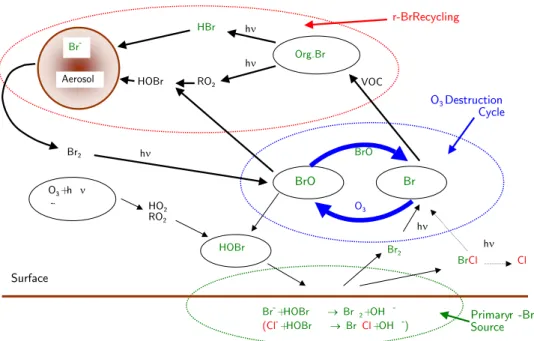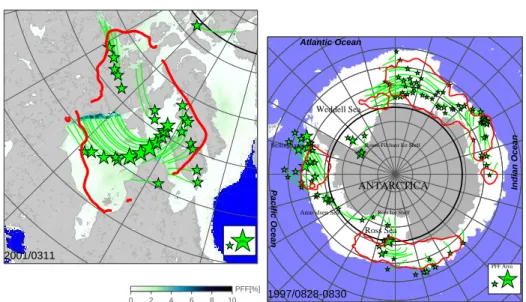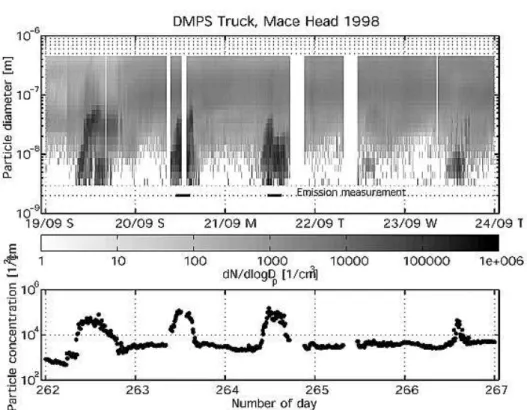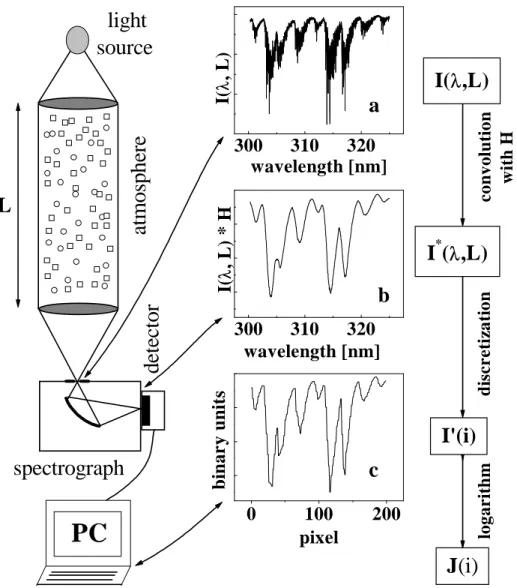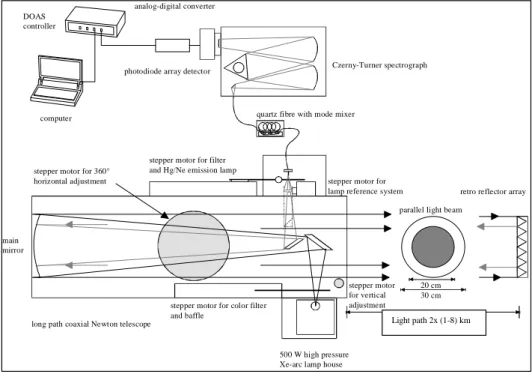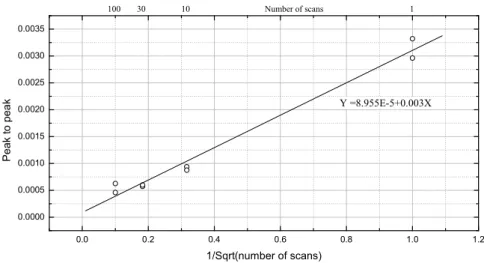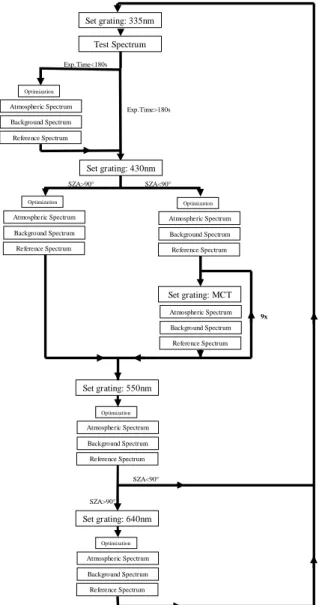Dissertation submitted to the
Combined Faculties for the Natural Sciences and for Mathematics of the Ruperto Carola University of Heidelberg, Germany
for the degree of Doctor of Natural Sciences
presented by
Diplom-Physicist: Christina Peters born in: W¨urselen
Oral examination: 06.07.2005
Studies of Reactive Halogen Species (RHS) in the Marine and mid-Latitudinal Boundary
Layer by Active Longpath
Differential Optical Absorption Spectroscopy
Referees: Prof. Dr. Ulrich Platt Prof. Dr. Frank Arnold
Untersuchungen von Reaktiven Halogenverbindungen (RHS) in der Ma- ritimen Grenzschicht und in Mittleren Breiten mit der Aktiven Langpfad DOAS Methode
Die Relevanz reaktiver Halogenverbindungen in der Troposph¨are ist einerseits be- legt durch den gravierenden Einfluss auf Ozon, welcher zum ersten Mal w¨ahrend des polaren Sonnenaufgangs in der vollst¨andigen Zerst¨orung bodennahem Ozons durch reaktive Bromverbindungen beobachtet wurde. Weiterhin werden reaktive Iodverbindungen in Zusammenhang mit aktuell beobachteter Partikelbildung in K¨ustengebieten gebracht. Da Partikel in der Atmosph¨are die mikrophysikalischen Eigenschaften von Stratocumulus Wolken beeinflussen, kann in diesen Beobach- tungen eine große Bedeutung f¨ur das Klima liegen. Im Rahmen der vorliegenden Arbeit wurden drei Feldmesskampagnen unter Verwendung der aktiven Langpfad DOAS Messmethode durchgef¨uhrt, um das Vorkommen von reaktiven Halogen- verbindungen, speziell BrO, IO, OIO und I2 in verschiedenen mittlereren Breiten zu untersuchen. W¨ahrend bodengebunder Messungen in der arktisch beeinflussten Region der Hudson Bay, Kanada wurden bis zu 35 ppt des BrO Radikals detek- tiert zeitgleich zur fast vollst¨andigen Zerst¨orung des bodennahen Ozons. Bei zwei weiteren Feldmesskampagnen zur Untersuchung der RHS in maritim beeinflussten Gebieten an der deutschen Nordseek¨uste und der franz¨osischen Atlantikk¨uste wurde IO als einziges Halogenoxid in beiden Umgebungen gefunden mit maximalen Kon- zentrationen von 7.7±0.5 ppt. In dieser maritimen Umgebung konnte BrO nicht oberhalb der Nachweisgrenze von 1.5 ppt nachgewiesen werden, ebenso verblieben OIO und auch I2 unterhalb der Nachweisgrenze. Eine Reanalyse von DOAS Spek- tren, die w¨ahrend einer vorangegangenen Kampagne 1998 in Mace Head, Irland gewonnen wurden, ergaben 61±12 ppt I2 w¨ahrend der Nacht und besonders tie- fem Wasserstand w¨ahrend Springtide. Diese Beobachtungen werden erkl¨art unter der Annahme, dass Laminaria Algen, die den unteren Intertidenbereich bewohnen, w¨ahrend dieser Zeit in Kontakt mit der Atmosph¨are molekulares Iod emittieren.
Studies of Reactive Halogen Species (RHS) in the Marine and mid- Latitudinal Boundary Layer by Active Longpath Differential Optical Ab- sorption Spectroscopy
The importance of reactive halogen species in the troposphere is on the one hand due to their strong effect on tropospheric ozone levels, which has been discovered for the first time during ozone depletion events in the polar boundary layer during polar sunrise. On the other hand recent field and laboratory studies are indicating a great relevance of reactive iodine in new particle formation processes. Since particles in the marine atmosphere affect the microphysical properties of stratocumulus clouds, they have a potential impact on climate. Within the framework of this thesis three field campaigns using active longpath DOAS technique for studies of the reactive
halogen species BrO, IO, OIO and I2 were conducted in different mid-latitudinal regions. Ground based measurements in the lower Arctic at the Hudson Bay yielded high levels of the BrO radical up to 35 ppt in the boundary layer, coinciding with nearly complete surface near ozone depletion. Two field campaigns investigated the appearance of RHS in the coastal environments of the German North Sea and the French Atlantic Coast, IO was the only halogen oxide found in both locations with concentrations reaching 7.7±0.5 ppt. BrO in the marine boundary layer was estimated to remain below 1.5 ppt, neither OIO nor I2 could be identified in the spectra. Within a re-analysis of spectra taken during a former campaign in 1998 in Mace Head, Ireland 61±12 ppt I2 were detected at night during extraordinary low water level most likely emitted by laminaria algae inhabiting parts of the lower intertidal zone.
Contents
1 Introduction 1
2 The Chemistry of Reactive Halogen Species in the Atmo-
sphere 4
2.1 Definition of RHS . . . 5
2.2 Ozone in the Atmosphere . . . 5
2.2.1 Stratosphere . . . 7
2.2.2 Troposphere . . . 8
2.3 RHS in the Atmosphere . . . 12
2.3.1 Impact of RHS on Ozone . . . 13
2.4 RHS in the Troposphere . . . 21
2.4.1 Reactive Bromine in the Troposphere . . . 22
2.4.2 Reactive Iodine in the Troposphere . . . 30
3 DOAS 41 3.1 The DOAS technique . . . 41
3.1.1 Absorption of Light . . . 42
3.1.2 Principles of the Analysis Procedure . . . 47
3.2 Active Longpath DOAS Instrument . . . 50
3.2.1 Telescope System . . . 51
3.2.2 Light Source . . . 52
3.2.3 Retro-Reflectors . . . 54
3.2.4 Quartz Fiber Mode Mixer . . . 55
3.2.5 Spectrograph . . . 56
3.2.6 Detector System . . . 56
3.2.7 Shortcut System . . . 57
3.2.8 Automated fiber alignment . . . 58
3.3 Characterization of the Detector System . . . 59
3.3.1 Offset . . . 59 5
3.3.2 Dark Current . . . 59
3.3.3 Residual Noise . . . 60
3.3.4 Dispersion, Resolution . . . 62
3.3.5 Memory Effect . . . 62
3.3.6 Diode Sensitivity Structure . . . 63
3.3.7 Measurement Routines . . . 64
3.4 Spectra Analysis and Evaluation Algorithms . . . 65
3.4.1 Software . . . 65
3.4.2 Spectra Preprocessing . . . 67
3.4.3 Differential Absorption Cross-Sections . . . 67
3.4.4 Convolution . . . 69
3.4.5 Systematic Errors . . . 70
3.4.6 Effects of Residual Structures . . . 70
3.4.7 Detection Limit . . . 72
3.5 Fitting Procedure and Retrieval of Trace Gas Concentrations 73 3.5.1 Analysis Procedure BrO . . . 73
3.5.2 Analysis Procedure IO . . . 75
3.5.3 Analysis Procedure I2, OIO . . . 75
3.6 Measurements of Organohalogens with GC/ECD-ICP-MS . . 78
4 Dageb¨ull, German North Sea Coast 80 4.1 Description of the Measurement Site . . . 80
4.1.1 Supplementary Measurements and Meteorology . . . . 81
4.1.2 Organohalogens . . . 82
4.1.3 Active Longpath DOAS Measurements . . . 87
4.1.4 Results of DOAS Measurements . . . 88
5 Brittany, French Atlantic Coast 90 5.1 Description of the Measurement Site . . . 91
5.1.1 Lightpaths for DOAS Measurements . . . 91
5.1.2 Meteorological Conditions and Supplementary Mea- surements . . . 93
5.1.3 Measurements of Organohalogens . . . 95
5.2 Active LP-DOAS Measurements . . . 96
5.2.1 Results of the IO Analysis . . . 97
5.2.2 Results of BrO Analysis . . . 104
5.2.3 Analysis of I2 and OIO . . . 107
5.2.4 Results of OIO and I2 at Brittany . . . 113
5.2.5 Comparison to Model Studies . . . 117
6 Appearance of OIO and I2 in the MBL 124
6.1 Mace Head 1998 . . . 125
6.1.1 Results of I2 Analysis . . . 126
7 Kuujjuarapik, Hudson Bay 132 7.1 Description of the Measurement Site . . . 134
7.2 Measurements in Kuujjuarapik . . . 136
7.2.1 Instrumental . . . 138
7.2.2 Meteorological Conditions . . . 138
7.2.3 Lead and Frostflowers . . . 141
7.2.4 Longpath DOAS Measurements . . . 141
7.2.5 MAX-DOAS Measurements . . . 146
7.2.6 Measurements of VHOCs . . . 146
7.2.7 Comparison of Ozone in-situ Monitors . . . 150
7.3 Discussion of Results from Hudson Bay Campaign . . . 151
7.3.1 BrO Event of March 23rd . . . 151
7.3.2 BrO Event of March 26th . . . 157
7.3.3 VHOCs as Precursor Species for Halogen Oxides . . . 158
7.3.4 Comparison to Campaign of 2001 . . . 160
7.3.5 Satellite Observations . . . 160
8 Conclusions and Outlook 162
List of Figures 167
List of Tables 169
Bibliography 183
Acknowledgements 187
Chapter 1
Introduction
It is well established that reactive halogen species (RHS) significantly influ- ence a variety of atmospheric processes. This is impressively demonstrated during polar spring, when boundary layer ozone is depleted within days or even hours by catalytic cycles involving bromine, the so-called ’bromine ex- plosion’ events, e.g. [Platt and Lehrer 1996].
The presence of haologen oxides outside polar regions could influence the ozone budget and the oxidation capacity of the troposphere by affecting the NO/NO2 and OH/HO2 partitioning, e.g. [Platt and H¨onninger2003].
On local scales the presence of BrO in mid-latitudinal regions could be ob- served so far in a variety of different environments, e.g. salt lakes [Hebestreit et al. 1999], [Stutz et al. 2002], [H¨onninger et al. 2004], [Zingler and Platt 2005] and volcanic plumes [Bobrowski et al. 2003] as well as in the ma- rine boundary layer ([Leser et al. 2003], [Saiz-Lopez et al. 2004]), whereas significant appearance of reactive iodine species (IO, OIO, I2 ) is presently reported mainly from coastal sites. IO could contribute to ozone destruction in a way comparable to BrO, even in low concentrations.
Additionally, recent field and laboratory studies are indicating a great rele- vance of reactive iodine in new particle formation processes [Hoffmann et al.
2001], [O’Dowd et al. 2002], [Jimenez et al. 2003], [Burkholder et al. 2004].
Events of particle formation with concentrations of up to 106 particles/cm3 have been observed in marine environments, e.g. [M¨akel¨a et al. 2002], [O’Dowd et al. 2002]. As particles in the marine atmosphere affect the microphysical properties of stratocumulus clouds, they have a potential im- pact on climate. Therefore, the investigation of sources, appearance and distribution of reactive iodine species on a global scale is of high interest in present research activities, and is addressed within this thesis, by three field
1
2 1. Introduction
campaigns, conducted in different mid-latitudinal regions.
The current understanding of the particle formation process is quite limited.
O’Dowd et al. [2002] proposed that particle formation in coastal environ- ments is dominated by polymerization of the OIO radical. However, field observations of OIO in the marine environment are rare [Allan et al. 2000], even though great effort was made for its detection. This, as well as ob- servations which will be presented in this thesis from two different coastal sites, seem to indicate that OIO is maybe present in the marine environ- ment, but in concentrations clearly below 10 ppt. These concentrations are insufficient to explain particle formation processes, according to Burkholder et al. [2004], thus they suggested an inhomogeneous source distribution in so-called ’hot spots’ to explain this apparent discrepancy. However, inho- mogeneous distribution of RHS along the lightpath cannot be resolved by longpath DOAS measurements, which were conducted for this work.
The most likely source of reactive iodine is the emission of organohalogens by macroalgae, which would excellently fit into the picture of inhomoge- neous release due to the patchy distribution of algae in coastal regions. Di- iodomethane is biogenically emitted by a variety of macroalgae as reported by e.g. [Schall and Heumann 1993], [Carpenter et al. 1999]. Due to the short photolytic lifetime of CH2I2, iodine atoms are released within minutes into the atmosphere, where they quickly react with ozone to form IO.
Recently, the detection of molecular iodine at Mace Head was reported by Saiz-Lopez and Plane [2004], who found highly elevated levels of I2 closely correlated to minima in tidal height indicating again macroalgae to be the source. These findings could be confirmed by a re-analysis of DOAS spec- tra, which was done in the framework of this thesis. However, it is unclear if the appearance of I2 is a common phenomenon in the marine boundary layer since the results have not been confirmed at further coastal sites so far.
Outline of the thesis
In the second chapter an overview on the impact of reactive halogen species on atmospheric chemistry is given. Reactive bromine and iodine chemistry are described both in detail, including a brief summary of the current knowl- edge of homogeneous nucleation of iodine oxides leading to observed particle burst events.
In the third chapter the measurement technique is introduced, starting with a general description of the DOAS method and the principles of the DOAS analysis procedure. In the following the application and the technical de-
3
scription and characterization of the main components of the active longpath DOAS telescope, which was used as the central measurement method for this thesis is given in full detail. Furthermore in this chapter an overview on the spectra analysis and evaluation procedure will be discussed, and the retrieval of concentrations for the species BrO, IO, OIO and I2 will be explained in detail.
In the fourth and fifth chapter the description and the results of the 2002 North Sea campaign and the 2003 Brittany campaign will be given. Both campaigns were conducted in coastal environments and the discussion of the results will be given in chapter 5, including a comparison of both mea- surement sites, which differed significantly in their bioactivity. A detailed description of the DOAS spectra for the detection of OIO and I2 will be given as well. Furthermore a comparison of the observations of the 2003 Brittany data was done with the marine boundary layer model MISTRA and the results of this model studies will be addressed at the end of chapter 5.
In the sixth chapter the re-analysis of the 1998 PARRFORCE campaign will be introduced, where molecular iodine in the DOAS spectra could be detected and the differences to the likewise bioactive coastal site of Brittany will be discussed.
In the sevethth chapter the description of the 2004 Hudson Bay campaign and a discussion of two observed BrO events will be given.
A short summary and outlook for future tasks in the halogen research is given in the last chapter.
Chapter 2
The Chemistry of Reactive Halogen Species in the
Atmosphere
In this chapter an overview on atmospheric chemistry involving Reactive Halogen Species (RHS) will be given. Sources, main reactions, and distri- bution of RHS will be discussed in the first section regarding the general aspects and in the following more special regarding bromine and iodine species.
The impact of RHS in the atmosphere is widespread. Especially the impor- tance of halogen oxides on the ozone budget in the atmosphere (stratosphere as well as troposphere) is of high relevance in atmospheric chemistry, due to the highly destructive potential in autocatalytic processes (Ozone holes).
By affecting the ozone budget, the oxidation capacity is as well influenced by halogen chemistry, since the loss of ozone by the catalytic reaction affects the NO/NO2 and OH/HO2 partitioning (e.g [Platt and H¨onninger2003]).
Moreover, studies in the last years show a potential impact of iodine on new particle production in coastal regions. Since particles in the MBL can affect the microphysical properties of stratocumulus clouds, the observed particle nucleation events may be relevant for the global climate. These findings are of current research interest and not well understood so far. An overview on the state-of-the-art knowledge on iodine chemistry on particle formation in coastal regions will be presented at the end of this chapter in Section 2.4.2.
4
2.1. Definition of RHS 5
Figure 2.1: Distribution of ozone in the atmosphere. More than 90%of the ozone is located within the stratosphere, acting as a protection shield against harmful UV-B radiation coming from the sun.
2.1 Definition of RHS
The term Reactive halogen species (RHS) includes the halogen atoms itself (X,Y = F, Cl, Br, I, At), the halogen molecules (X2), the interhalogen compounds (XY), the halogen monoxides (XO) and the higher oxides XnOm as well as the hypohalous acids (HOX). The reactivity of RHS is relatively high in comparison to hydrogen halides (HX) or halogen-NOx compounds (XNOx).
2.2 Ozone in the Atmosphere
In 1985 the discovery of the ozone hole by Farman et al. [1985] led to great interest in atmospheric chemistry involving halogens. Already in the 1970ies it was postulated by Molina and Rowland [1974] that the release of industrially produced halocarbons, in particular the chlorofluorocarbons (CFCs) CFCl3 and CF2Cl2 could cause severe depletion of stratospheric ozone, by reactions involving the photolytical products from CFC radicals
6 2. The Chemistry of Reactive Halogen Species in the Atmosphere
Spec. Location Max.
Conc.
[ppt]
Error
±(2σ) [ppt]
Reference
IO Mace Head, Ireland (1997)
6.7 0.5 Alicke et al. [1999]
IO Mace Head (1998) 7.2 0.3 Hebestreit[2001]
IO Mace Head (2002) 7 0.5 Saiz-Lopez and Plane [2004]
IO Tasmania (1999) 2.2 0.4 Allan et al. [2000]
IO Tenerife, Can. Islands (1997)
3.5 0.4 Allan et al. [2000]
IO Kerguelen, Ind. Ocean (2002)
≤D.L. (1.4) 1.4 Sebasti´an[2004]
IO North Sea, Germany (2002)
2.1 0.5 this work
IO Atlantic Coast, France (2003)
7.7 0.5 this work
IO Crete, Greece (2003) ≤D.L. (0.8) 0.8 H¨onninger [2002]
IO Dead Sea, Israel (2000) 10 2.4 Zingler and Platt[2005]
IO Antarctic and Arctic 10 - Frieß et al. [2001], Wittrock et al. [2000]
IO Alert, Arctic (2000) 0.73 0.23 H¨onninger [2002]
OIO Cape Grim, Tasmania (1999)
3.0 0.5 Allan et al. [2001]
OIO Mace Head, Ireland (1998)
6.7 0.5 Hebestreit[2001]
OIO Mace Head, Ireland (2002)
3.0 0.5 Saiz-Lopez and Plane[2004]
I2 Mace Head, Ireland (2002)
93 3 Saiz-Lopez and Plane[2004]
I2 Mace Head, Ireland (1998)
61.3 12 this work
BrO Mid.Lat. MBL 6.0 - Leser et al. 2003, Saiz-Lopez
et al. [2004]
BrO Salt lakes (Dead Sea, Salt Lake City, Caspian Sea, Salar de Uyuni)
176 - Hebestreit et al. [1999],Matveev et al. [2001], Wagner et al.
[2001], Stutz et al. [2002], H¨onninger et al. [2004]
BrO Antarctic, Arctic 30 - Hausmann and Platt [1994],
Tuckermann et al. [1997],Hegels et al. [1998], Martinez et al.
[1999], H¨onninger et al. [2004], Frieß[2001]
BrO Volcanoes ∼1000 - Bobrowski et al. [2003]
Table 2.1: Observation of RHS in the troposphere by active and passive DOAS technique.
2.2. Ozone in the Atmosphere 7
Figure 2.2: The Chapman cycle
Cl and ClO as catalysts.
2.2.1 Stratosphere
More than 90% of the total atmospheric ozone is located in the stratosphere.
The maximum concentration is in 15-30 km altitude in the so-called ozone layer (see Fig. 2.1). Stratospheric ozone is considered as strongly important for humans and other life forms because it absorbs ultraviolet (UV)-B radi- ation coming from the sun, which can severely affect the health of humans, animals and plants.
In 1930 the first theory on the photochemical formation of ozone in the stratosphere predicting a maximum around 20 km was proposed by Chap- man [1930].
Formation and destruction of ozone in the stratosphere is described by the so-called odd-oxygen chemistry, where the production of ozone is initiated by the photolysis of molecular oxygen [Chapman 1930].
O2+hν −→2O(3P) λ≤242 nm (2.1a)
O(3P) +O2+M −→O3+M (2.1b)
Ozone is formed via the reaction (2.1b) of O + O2 with a collision partner M. The following reactions lead to destruction of ozone:
8 2. The Chemistry of Reactive Halogen Species in the Atmosphere
O3+hν −→O2+O(1D) λ≤320 nm (2.2a)
O(1D) +M −→O(3P) +M (2.2b)
O3+hν −→O2+O(3P) λ≤1180 nm (2.2c)
2O(3P) +M −→O2+M (2.2d)
O(3P) +O3 −→2O2 (2.2e)
Photolysis of ozone (2.2a and 2.2b) besides the reaction 2.1b interconverts O and O3, which are the rationales of the concept of odd oxygen, whereas O2
represents the even oxygen. Reaction 2.2e is the main loss process for odd oxygen in the chapman cycle, as reaction 2.2d is known to be too slow to be important for stratospheric chemistry. A sketch of the chapman cycle is shown in Figure 2.2. By observations it turned out, that the chapman cycle alone cannot explain the real ozone profiles. As the calculated stratospheric ozone abundance comprising only oxygen chemistry is overestimated by a factor 2, more ozone destroying mechanisms have to be considered. The ob- served lower ozone levels were subsequently explained in the following years by stratospheric chemistry cycles involving species such as hydrogen and nitrogen as well as halogen compounds ([Bates and Nicolet 1950; Crutzen 1970; Johnston1971; Crutzen 1973]), see Figure 2.3.
2.2.2 Troposphere
UV light below 240 nm is necessary to photolyze O2 via the reaction 2.1a, thus the production mechanism of ozone in the troposphere must be prin- cipally different from that in the stratosphere. It was commonly assumed until the late 1970s that tropospheric ozone has its origin in the stratosphere (e.g. Junge [1963]). It was believed that stratospheric ozone was mixed through the tropopause region exhibiting a gradient towards the earth’s surface, which was thought to be the dominant sink. It was found by Fish- man and Crutzen[1978] that only 50% of the tropospheric ozone could have its origin in the stratosphere, as the additional source they proposed the production of ozone in the troposphere by NOx chemistry and reactions involving methane and other reactive hydrocarbons. A key sequence for the formation and destruction of tropospheric ozone are reactions involving NOx:
2.2. Ozone in the Atmosphere 9
Figure 2.3: Comparison between observed and modelled stratospheric ozone mix- ing ratios, if only the Chapman cycle is taken into account and by taking HOx, NOx and ClOx chemistry into account (adapted from R¨oth [1994]).
N O2+hν −→N O+O(3P) λ≤420 nm (2.3a) O(3P) +O2+M −→N O+O3+M k1= 1.5·10−14 (2.3b) N O+O3−→N O2+O2 k2= 1.8·10−12 (2.3c) with the rate constants given in units ofcm3molec−1s−1. The ozone concen- tration is then determined by the photo-stationary steady state of reaction cycles Eq. (2.3), which can be expressed as the so-called Leighton-ratio L:
L≡ [N O]
[N O2] = J(N O2)
[O3]·k2 (2.4)
In contrast to anthropogenic influenced areas, remote regions are character- ized by NOx mixing ratios below 5-10 ppt.
Under conditions of more elevated levels of NOx, nitrogen and hydrogen oxides are able to produce ozone by the degradation of methane or higher
10 2. The Chemistry of Reactive Halogen Species in the Atmosphere
hydrocarbons in the following reaction sequence:
CH4+OH−→CH3+H2O (2.5a)
CH3+O2+M −→CH3O2+M (2.5b) CH3O2+N O−→CH3O+N O2 (2.5c) CH3O+O2−→CH2O+HO2 (2.5d) CH2O+hν −→50% HCO+H (2.5e) CH2O+hν −→50% H2+CO (2.5f) HCO+O2+M −→CO+HO2+M (2.5g)
H+O2+M −→HO2+M (2.5h)
HO2+N O−→OH+N O2 (2.5i)
N O2+hν −→N O+O (2.5j)
O+O2+M −→O3+M (2.5k)
net: CH4+x·O2−→CO+ 2H2O+y·O3
The number of ozone molecules produced by the degradation of one methane molecule is ∼2.5. Similar reaction schemes to that described above (Eq.
2.5) can also involve higher hydrocarbons. Besides the production of ozone, this reaction mechanism is an important source of CO in the troposphere.
Furthermore, CO can produce additional ozone according to Fishman and Crutzen [1978]:
CO+OH −→CO2+H (2.6a)
H+O2 +M −→HO2+M (2.6b)
HO2+N O −→OH+N O2 (2.6c)
N O2+hν −→N O+O (2.6d)
O2+O+M −→O3+M (2.6e)
net: CO+ 2O2 −→CO2+O3
This reaction mechanism requires sufficient presence of NOx, above the threshold of typically 10 ppt, which represent conditions of remote areas.
Instead, CO and hydrocarbons lead to destruction of ozone under low NOx conditions:
2.2. Ozone in the Atmosphere 11
CO+OH−→CO2+H (2.7a)
H+O2+M −→HO2+M (2.7b)
HO2+O3 −→OH+ 2O2 (2.7c) net: CO+O3 −→CO2+O2
Typical ozone concentrations found in the unpolluted marine boundary layer range from ∼13 ppb during summer to ∼30 ppb during winter [Gros et al.
1998]. This pronounced seasonal variation of ozone is partly due to the seasonal variation of O3 input from the stratosphere and by long range transport of ozone producing pollutants from biomass burning. Ozone min- ima during summer can be explained by photochemical O3 depletion , which is controlled by the availability of OH radicals. The concentration of OH depends on the solar flux since OH is generated by the photolysis of O3 to O(1D), followed by its reaction with water vapor:
O3+hν −→O2+O(1D) λ≤320 nm (2.8a)
O(1D) +H2O−→2OH (2.8b)
Removal of OH occurs for example via reaction with CO (2.6a and 2.7a), with CH4 (2.5a) or reactions with other hydrocarbons.
The dramatic impact of halogen chemistry on the ozone budget is demon- strated during polar sunrise. Catalytic destruction of ozone leads to some- times complete depletion of surface-near ozone, a tropospheric ozone hole.
This phenomenon is strongly correlated to bromine chemistry in the tropo- sphere and will be explained in detail in the next sections since the further investigation of this was one topic of this thesis (see Chapter 7). Moreover there are a variety of field studies at mid-latitudes showing a behavior of ozone mixing ratios, which could not be explained by the standard OH and NOx chemistry. For example measurements by Nagao et al. [1999] and Dickerson et al. [1999] indicate already that halogen chemistry may play a significant role in the remote marine boundary layer at mid-latitudes as well as low-latitudes.
12 2. The Chemistry of Reactive Halogen Species in the Atmosphere
2.3 RHS in the Atmosphere
Within the last years significant amounts of halogen oxides, mainly BrO and IO were found in a variety of different environments in the troposphere, mainly reported in the marine boundary layer (MBL), besides a more local- ized appearance at salt lakes and volcanoes.
The most drastic effect of bromine chemistry is observed in polar regions, where the increase of BrO mixing ratios coincides with sudden ozone deple- tion events. These events are reported for both, the Arctic (e.g. [Hausmann and Platt 1994], [McElroy et al. 1999], [H¨onninger et al. 2004]) and the Antarctic (e.g. [Kreher et al. 1997], [Frieß 2001]) boundary layer during polar sunrise. BrO clouds covering extended areas of several million square kilometers at both hemispheres are regularly observed during polar spring by satellite observations [Wagner and Platt1998;Richter et al. 1998;Hegels et al. 1998]. Moreover, these areas are found to increase in longtime obser- vations by GOME (Global Ozone Monitoring Experiment) during 1996 to 2001 by 10% as reported by [Hollwedel2005].
Enhanced BrO in the boundary layer with coinciding ozone destruction was also detected at salt lakes e.g. [H¨onninger et al. 2004], [Stutz et al. 2002], at the Dead Sea [Hebestreit et al. 1999] and the Caspian Sea [Wagner et al.
2001]. Studies by van Roozendael et al. [2000] suggest a free tropospheric background of 1-3 ppt BrO, according to multi-platform observations.
Recently, high amounts of BrO were found in volcanic plumes [Bobrowski et al. 2003]. Further observations of RHS in volcanic plumes give also good indications that ClO may be present as well [Bobrowski 2005]. Besides that, the only detection of ClO is reported by Stutz et al. [2002] during field measurements at the Great Salt Lake, Utah.
The first observation of IO was reported byAlicke et al. [1999]. They found IO up to 6 ppt in Mace Head, Ireland. Since then, IO was reported from various coastal regions such as Tenerife, Canary Islands and Cape Grim, Tasmania [Allan et al. 2000]. The detection of IO is also reported from the Arctic [Wittrock et al. 2000] and the Antarctic [Frieß et al. 2001] and from the Dead Sea [Zingler and Platt2005]. In Table 2.1 an overview on detected RHS at various location and the respective detected concentration is given.
The main reaction schemes of the halogens Cl, Br and I in the troposphere appear to be similar. The differences regarding the rate constants and quantum yields concerning their photochemical reaction channels will be discussed later in this chapter.
Since the reactions for the different halogens involved are very similar X and Y will be used instead of the chemical symbols Cl, Br and I. In Table
2.3. RHS in the Atmosphere 13
2.2 and 2.3 the state-of-the-art rate constants and photolysis frequencies of RHS which are important regarding the two different ozone destruction cycles, are given.
2.3.1 Impact of RHS on Ozone
Halogen oxides (X,Y) and their monoxides (XO, YO) are the key species in the catalytic ozone destruction cycles [Hausmann and Platt 1994], [LeBras and Platt1995], [Platt and Janssen1995]. The halogen oxide itself is formed by the reaction with ozone (see Eq. 2.9a).
Cycle I:
X +O3 −→XO+O2 (2.9a)
Y +O3 −→Y O+O2 (2.9b)
XO+Y O−→X +Y +O2 (2.9c)
−→XY +O2 (2.9d)
−→OXO+Y (2.9e)
net: 2O3 −→3O2
The halogen atom (X,Y) reacts very fast with the ozone, what leads to short lifetimes of the halogen atom in the troposphere (τ(Cl) = 0.13s, τ(Br) = 1.3s, τ(I) = 1.3s, assuming a concentration of 50 ppb ozone).
The reaction products and the current branching ratios for the halogen oxide self- and cross reactions is given in Table 2.4.
Halogen or interhalogen compounds (XX, XY) are formed via reaction 2.9d, but photolyze quickly during daytime:
XY +hν −→X +Y (2.10)
The reaction 2.10 does not lead to a net destruction of ozone, since the photolysis of OXO leads to the formation of oxygen atoms, which recombine with O2 to form O3:
OXO+hν −→XO+O (2.11a)
O+O2+M −→O3+M (2.11b)
For X=I, the photo-dissociation of OIO may yield I and O2, thus a net ozone destruction [Allan et al. 2001], [Hebestreit2001]. This will be more detailed discussed in Section 2.4.2. The reaction XO with YO is the rate limiting step of the reaction cycle 2.9. Halogen oxide self reactions are usually slower
14 2. The Chemistry of Reactive Halogen Species in the Atmosphere
Reaction k [molec·scm3 ] Reference
ClO + ClO −→ Productsa k=1.63·10−14 [Atkinson et al. ] BrO + ClO −→ Products k=1.4·10−11 [Atkinson et al. ] IO + ClO −→ Products k=1.2·10−11 [Atkinson et al. ] BrO + BrO −→ Products k=3.2·10−12 [Atkinson et al. ] BrO + IO −→ Products k=8.5·10−11 [Atkinson et al. ] IO + IO −→ Products k=9.1·10−11 [Atkinson et al. ] Cl + O3 −→ ClO + O2 k=1.2·10−11 [Atkinson et al. ] Br + O3 −→ BrO + O2 k=1.2·10−12 [Atkinson et al. ] I + O3 −→ IO + O2 k=1.2·10−12 [Atkinson et al. ] ClO + HO2 −→ HOCl + O2 k=6.9·10−12 [Atkinson et al. ] BrO + HO2 −→ HOBr + O2 k=2.4·10−11 [Atkinson et al. ] IO + HO2 −→ HOI + O2 k=8.4·10−11 [Atkinson et al. ] ClO + NO2 + M −→ ClONO2 + M k=1.9·10−12 [Atkinson et al. ] BrO + NO2 + M −→ BrONO2 + M k=2.7·10−12 [Atkinson et al. ] IO + NO2 + M −→ IONO2 + M k=3.5·10−12 [Atkinson et al. ]
aSee reactions 2.9c, 2.9d and 2.9e for the possible products.
Table 2.2: List of rate constants taken from IUPAC: Summary of Evaluated Kinetic and Photochemical Data for Atmospheric Chemistry, July 2004.
than the cross reactions and especially cross reactions involving iodine (X
= I, Y = Cl, Br) are very efficient in ozone destruction.
2.3. RHS in the Atmosphere 15
Reaction photolysis frequency j [1s]
Cl2+hν −→ 2Cl j = 0.0023
Br2+hν −→ 2Br j = 0.032
I2+hν −→ 2I j = 0.152
BrCl+hν −→ Br+Cl j = 0.0104
IBr+hν −→ I+Br j = 0.069
ICl+hν −→ I+Cl j = 0.023
ClO+hν −→ Cl+O j = 0
BrO+hν −→ Br+O j = 0.035
IO+hν −→ I+O j = 0.435
HOCl+hν −→ Cl + OH j = 2.35·10−4 HOBr+hν −→ Br + OH j = 2.2·10−3 HOI+hν −→ I + OH j = 5.9·10−3 ClONO2+hν −→ products j = 4.6·10−5 BrONO2+hν −→ products j = 0.0126 IONO2+hν −→ products j = 0.0037
Table 2.3: Photolysis frequencies at noon, calculated for 48◦N clear sky conditions in the marine atmosphere for SZA 22◦ [von Glasow et al. 2002a], [Landgraf and Crutzen 1998].
Cycle II involves HOx radical:
X +O3 −→XO+O2 (2.12a)
OH+O3 −→HO2+O2 (2.12b)
XO+HO2 −→HOX+O2 (2.12c)
HOX +hν −→OH+X (2.12d)
net: 2O3+hν −→3O2
162.TheChemistryofReactiveHalogenSpeciesintheAtmosphere
ClO kXO+YO
[10−12molec·scm3 ] BrO kXO+YO
[10−12molec·scm3 ] IO kXO+YO
[10−12molec·scm3 ]
ClO
−→ Cl2Oa2
−→29% Cl2+O2
−→50% Cl+ClOO
−→21% Cl+OClO
1.6×10−2b
−→44% Br+Cl+O2
−→7% BrCl+O2
−→49% OClO+Br
13.9b
−→55% I+OClO
−→25% I+Cl+O2
−→20% ICl+O2
6.1c
BrO
−→85% Br+Br+O2
−→15% Br2+O2
3.2b
≤30%−→ I+Br+O2
≤5%−→ IBr+O2 65−93%
−→ OIO+Br
≤15%−→ OBrO+I
∼0%−→ IBrO2+M
85d
IO
−→ 2I+O2
−→ I2+O2
∼40%−→ OIO+I
∼60%−→ I2O2+M
82e
kXO+YO kBrO+BrO
kClO+ClO
kBrO+BrO=5×10−3
kClO+BrO
kBrO+BrO = 4.3
kBrO+BrO
kBrO+BrO = 1
kClO+IO
kBrO+BrO = 1.9
kBrO+IO
kBrO+BrO = 27
kIO+IO
kBrO+BrO = 26
a not stable in the troposphere due to thermal decomposition d [Rowley et al. 2001]
b rate constant and branching ratios taken from [DeMore et al. 1997] e[Crowley 2004]
c [Bedjanian et al. 1997]
Table 2.4: Rate constants and branching ratios of halogen oxide self- and cross-reactions
2.3. RHS in the Atmosphere 17
Reactive bromine is the most important species for catalytic ozone destruc- tion in the troposphere. At 15 ppt BrO the net effect of the HOx cycle (Cycle II) is comparable to that of Cycle I (at a typical level of 1 ppt HO2).
Note that the efficiency of Cycle II is linearly dependent on the XO concen- tration, whereas the XO dependence of Cycle I is quadratic. Thus at high XO levels Cycle I will dominate, at low XO Cycle II. At 30 ppt BrO, which are observed during ozone depletion in the Arctic boundary layer, 66% of the ozone destruction takes place via Cycle I. In addition, the efficiency of Cycles I and II can be enhanced by the presence of other halogen oxide species (i.e. IO, ClO) due to cross reactions (e.g. reaction 2.9c for BrO + IO) when reaction 2.9b occurs with IO or ClO instead of BrO.
An important loss channel for the halogen oxide formed in reaction (2.9a) is its photolysis and the reaction with NO:
XO+hν −→X +O (2.13a)
XO+N O−→X +N O2 (2.13b)
The photolysis of halogen oxides of Eq. 2.13a leads to a null cycle with respect to ozone destruction since the oxygen atom formed, quickly recom- bines with O2 to yield ozone (reaction 2.11b).
Stutz et al. [1999] calculated the importance of the different cycles for the ozone destruction rate d[Odt3]as a function of the NOxmixing ratio (see Figure 2.4) for given 6 ppt iodine oxide.
Assuming no loss of reactive halogens and including all self and cross reac- tions leading to O3 destruction channels, an upper limit of the ozone loss rate as a function of XO concentration can be expressed as:
−d[O3]
dt = 2·X
i,j
kXiO+YjO[XiO][YjO] +X
i
kXiO+HO2[XiO][HO2] (2.14) where the combined effects of the cycles I (including all self and cross reac- tions) and cycle II are taken into account.
At high NOxconcentrations the exchange reactions with the reservoir species XONO2 can significantly alter the partitioning of reactive halogen species.
XO+N O2−→XON O2 (2.15a) XON O2+hν −→XO+N O2 (2.15b)
18 2. The Chemistry of Reactive Halogen Species in the Atmosphere
0.01 0.1 1
-0.5 -0.4 -0.3 -0.2 -0.1 0.0
B CH
3O
2+ NO
HO2+ NO IO + IO
HOI cycle
total d(O3)/dt[ppb/h]
NOX[ppb]
0 2 4
6 A
IO[ppt]
Figure 2.4: Ozone destruction rates of the different catalytic reaction cycles for the case of iodine, as a function of the NOxconcentration (adapted from Stutz et al.
[1999]).
However, these reactions represent a null cycle with no net chemistry unless the photolysis of XONO2 takes place in the XO + NO2 channel. If X + NO3 were formed instead, additional O3 loss would result.
Apart from its importance for the destruction of ozone the reaction of halo- gen oxides with hydroperoxy radicals (2.12c) followed by the photolysis of the product from this reaction, the hypohalous acids HOX (2.12d), also have a strong influence on the ratio of OH/HO2 [Stutz et al. 1999; Hebe- streit 2001]. In analogy to reaction 2.12c, XO can also react with organic peroxy radicals (RO2, R = organic group), e.g. the methyl peroxy radical, CH3O2, instead of HO2. It has been shown in laboratory experiments that this reaction is very efficient for X = Br [Aranda et al. 1997]. HOBr was formed in about 80 % of the reactions.
The efficiency of the catalytic ozone destruction cycles involving halogen rad- icals strongly depends on the number of cycles that the reactive compounds X and XO can pass before being lost to a reservoir species. Regarding the halogen group from fluorine over chlorine and bromine to iodine, the re- activity of the halogen atoms decreases strongly. To assess the role of a halogen species in ozone destruction the branching ratio for the reaction of X with ozone (2.9a) and the reactions with hydrocarbons RH has to be con- sidered. For bromine and iodine the reactions with HOx are also important
2.3. RHS in the Atmosphere 19
branching reactions:
X +RH −→HX+R (2.16a)
X +HO2 −→HX+O2 (2.16b)
XO+HO2 −→HOX+O2 (2.16c)
Fluorine atoms released in the troposphere react very quickly with atmo- spheric water vapor, which is much more abundant than hydrocarbons (e.g.
CH4). HF is stable against photolysis or reaction with OH. Therefore flu- orine will always remain in this passive form and has no effect on ozone chemistry [Wayne et al. ].
Chlorine atoms react rapidly with CH4 and other hydrocarbons to form HCl. However, Cl can be in principle be activated by reaction of HCl with OH, and under certain circumstances it is released as a byproduct of auto- catalytic bromine release (see section 2.4.1).
Bromine atoms only react with unsaturated hydrocarbons and already oxi- dized compounds like aldehydes.
Iodine atoms almost exclusively react with ozone or other radicals.
The relative reaction rate R RO3
O3+P
RRH+RHO2 is a measure of the probability of the reaction of a halogen atom with ozone. In Table 2.5 the situation for the four halogens is listed.
Table 2.5 show, that fluorine is of no importance in the atmosphere since conversion to HF is very fast. Therefore, only the reactive halogen species chlorine, bromine and iodine are considered. In the case of chlorine about half of it is consumed by the reaction with hydrocarbons. For bromine, however, the probability for reaction with ozone is 98% and even higher with almost unity for iodine.
Assuming that all XO radicals formed in the reaction of X with O3 are 100%
reconverted to X atoms by self and cross reactions, the fraction of the rates RO3 of reaction 2.9a and the sum of the rates RRH + RHO2 of reactions 2.16a and 2.16b, PR RO3
RH+RHO2 is an approximation of the mean number of catalytic ozone destruction cycles that a halogen atom can pass. From the last column in Table 2.5 one can see that Br and especially I are much more efficient in destroying ozone than Cl.
To describe the partitioning between the main RHS X and XO the ratio of the halogen oxide concentration [XO] and the corresponding halogen atom [X] is determined by the relative rates of the reactions which convert X into XO (the halogen reaction with ozone 2.9a and the reaction with hydrocar- bons RH and HOx (2.16a, 2.16b) and the reactions transforming XO to X
202.TheChemistryofReactiveHalogenSpeciesintheAtmosphere
X RH k∗X+RH typ[RH] RRH =kX+RH[RH]
(kX+O3) (typ[O3]) (RO3 =kX+03[O3]) R RO3
O3+P
RRH+RHO2
RO3
PRRH+RHO2
[cm3s−1] [cm−3] [s−1]
F H2O 1.4·10−11 7·1016 2.8·106 3.5·10−6 3.5·10−6 CH4 6.4·10−11 4.0·1013 2.6·103
PRRH = 2.8·106 (O3 1.0·10−11 1.0·1012 10.0)
Cl CH4 1.0·10−13 4.0·1013 4.0 0.52 0.92
C2H6 5.7·10−11 3.0·1010 1.7 C3H8 1.4·10−10 1.0·1010 1.4 CH2O 7.3·10−11 1.0·1010 0.73 C2H2 2.1·10−10 1.0·1010 2.1 C2H4 3.1·10−10 5.0·109 1.5
PRRH = 11 (O3 1.2·10−11 1.0·1012 12.0)
Br CH2O 1.1·10−12 1.0·1010 0.01 0.984 60 HO2 2.0·10−12 1.0·10−8 2.0·10−4
PRRH = 2.0·10−2 (O3 1.2·10−12 1.0·1012 1.2)
I HO2 3.8·10−13 1.0·108 3.8·10−5 0.99997 3.1·104 (O3 1.2·10−12 1.0·1012 1.2)
∗rate constants taken f rom[DeMore et al. 1997]
Table 2.5: Comparison of the branching between reaction 2.16a, 2.16b and 2.9a. The 6th column is a measure of the probability of the reaction with ozone, the last column can be seen as a zero order approximation for the number of ozone destruction cycles a halogen atom can pass before being lost to the reservoir.
2.4. RHS in the Troposphere 21
Figure 2.5: Schematic overview of tropospheric halogen chemistry (X = Cl, Br, I), adapted from Platt and Janssen [1995]. Heavy lines indicate ozone-destruction sequences. Sources of RHS are the release from sea salt and the photolysis of halo- carbons.
(NO reaction, self- or cross-reaction and photolysis (2.13b, 2.9c, 2.13a)):
[XO]
[X] = kX+O3[O3] +kX+RH[RH]
kXO+N O[N O] + 2·kXO+XO[XO] +kXO+Y O[Y O] +J(XO) (2.17) Due to the fast photolysis of the IO radical the IO/I ratio is between 1 and 10 for typical NOx and O3 levels (e.g. [Platt and Janssen 1995; Vogt et al. 1996]). This is significantly lower than that of the other halogens.
BrO/Br and ClO/Cl are of the order of 100 and 1000 respectively [Barrie et al. 1988].
Figure 2.5 shows a schematic overview of the halogen chemistry in the tro- posphere (adapted from Platt and Janssen[1995]).
2.4 RHS in the Troposphere
Mainly two natural sources are currently known to release halogens into the atmosphere.
1. Release of inorganic halogen compounds from sea-salt
22 2. The Chemistry of Reactive Halogen Species in the Atmosphere
SLS<! SSS oSSS SLS!< S w]jSLS<! SSS oSSS ]jSLS!< D
z!]S
YQS YQS
YQS
YQS
S
!S !S
<! S i!S
< S
<! S
!S S
!S S
!SLSY QS
SS S <!S
i!S S
VBRBjS S
]jSS ]jSS
T Si{k{j$t S
!S*RZ{$Bt S SSS SSSSSSSSS ]k{jS
_$8skS T S 7BZ{S 7ZPs{S
YQS
Figure 2.6: Overview of the tropospheric bromine chemistry including the bromine explosion mechanism.
2. Photolytic degradation of halogenated organic molecules (organohalo- gens) from terrestrial and marine sources. Some organohalogens have relatively short photolytic lifetimes in the lower atmosphere, providing a source of reactive halogen atoms in the troposphere. In contrast, long-lived organohalogens can be transported through the tropical tropopause into the stratosphere where they can affect stratospheric ozone.
These two different types of release processes will be the subject of the next section. The inorganic release of halogen compounds mainly important for bromine and chlorine, since the partitioning of sea salt Br−/I− is in the order of 104, whereas iodine species are mostly emitted by biogenic sources.
Therefore, the following sections are focused on the respective halogen.
2.4.1 Reactive Bromine in the Troposphere
The composition of sea salt is dominated by Cl− with 55.7%, followed by 0.19% Br− and only 2·10−5%I−. Sea salt is deposited on sea ice surfaces, snow and aerosol particles in close contact to the atmosphere. Thus a large
2.4. RHS in the Troposphere 23
Figure 2.7: Frostflowers and open lead observed in Kuujjuarapik during 2004 Hudson Bay campaign.
reservoir of halogens is available at coastal lines and over open oceans.
The role of bromine in the ozone depletion events (ODE) during polar spring is well established. Under presence of sun light tropospheric ozone can be destroyed completely by catalytic reaction cycles involving gaseous reactive bromine, leading to the tropospheric ozone hole. The catalytic ozone destruction cycle is interlinked with autocatalytic bromine release due to heterogenous reactions on highly saline surfaces [Fan and Jacob 1992], [Mozurkewich1995], [Tang and McConnel1996]. These surfaces or aerosols that have higher salt concentrations than sea water [Koop et al. 2000] can be provided by frost flowers over freshly formed sea ice [Rankin et al. 2002], [Kaleschke et al. 2004]. Open leads and polynias (linear breaks in the ice) can supply bromide to ice surfaces as well.
Under certain circumstances, including a stable boundary layer, the avail- ability of sunlight and HO2, these processes can lead to an exponentially increasing release of reactive bromine into the gasphase, being described by the so-called bromine explosion [Platt and Lehrer 1996]. Bromine radicals can be formed in presence of sunlight from photolyzable bromine:
Br2+hν −→2Br λ≤600nm (2.18a)
Br+O3 −→BrO+O2 (2.18b)
BrO can be recycled by photolysis, leading to a null cycle, or by its self- reaction:
24 2. The Chemistry of Reactive Halogen Species in the Atmosphere
BrO+BrO−→2Br+O2 (2.19a)
BrO+hν −→Br+O (2.19b)
The reaction with HO2 leads to HOBr:
BrO+HO2 −→HOBr+O2 (2.20a)
which can undergo heterogenous reactions in the liquid phase or on dry ice surfaces as aerosols, frost flowers or salt surfaces, where reactions with halogen ions take place. According to Fickert et al. [1999] the uptake of HOBr on aqueous Cl−/Br− solutions with pH ≤ 6.5 exceeds 90%, the acidification of sea alt can be provided by acids like HNO3 or H2SO4 or even by self-acidification as proposed byvon Glasow and Sander [2001]. In the aqueous phase the reaction with halogen ions takes place, leading to the release of Br2 into the atmosphere.
HOBraq+Braq− +Haq+ −→Br2aq+H2O (2.21a)
Br2aq −→Br2 (2.21b)
or the reaction of HOBr with Cl− ions leads to the formation of BrCl HOBraq+Cl−aq+Haq+ −→BrClaq+H2O (2.22a)
BrClaq −→BrCl (2.22b)
Br2 and BrCl can be released to the atmosphere, where they quickly pho- tolyze (see Table 2.2). Reaction type 2.21 is enhanced compared to 2.22 (see [Wang et al. 1994], [Foster et al. 2001]), what leads to a significant increase in reactive gaseous bromine and the bromine explosion can take place lead- ing to the formation of tropospheric ozone holes. The bromine explosion stops if the heterogeneous reservoir ceases to exist due to breaking/melting ice and snow or by loss reactions.
Sinks and Lifetime of BrO
The photolytic lifetime of BrO (Eq. 2.19b) at SZA 70◦ranges between 30 to 100 s. The second important reaction channel of BrO besides the photolysis
2.4. RHS in the Troposphere 25
is the BrO self-reaction
BrO+BrO −→85% Br+Br+O2 (2.23)
−→15% Br2+O2 (2.24)
The lifetime with respect to the selfreaction is:
τBrO = 1
[BrO]·kBrO+BrO (2.25)
At 10 ppt (2.6·108 molec/cm3) this leads to a lifetime of τBrO of 1200 s.
This lifetime of BrO is inversely proportional to the square of the BrO con- centration, therefore at 40 ppt the BrO lifetime would be only 300 s. During daytime, the Br2 produced with a quantum yield of ∼0.15 is rapidly pho- tolyzed (τBr2 ∼30 s to 1 min) to yield Br atoms.
Bromine atoms can react with oxidized or unsaturated hydrocarbons (e.g.
formaldehyde HCHO, olefines), HO2radicals or ozone in the following path- ways:
Br+RH −→2% HBr+R (2.26)
Br+O3 −→98% BrO+O2 (2.27) RH denotes the sum of HO2, HCHO and olefines which react with Br atoms.
As long as ozone is not completely depleted ([O3] > several ppb), almost all Br atoms (>98%) react with ozone leading to no net BrO loss. For the branching ratios see Table 2.5. Depending on RH levels the effective conversion time of BrO to HBr can be up to ∼5000 s. Since the BrO self reaction is significantly faster, it leads to efficient ozone destruction.
As it takes about one day to completely destroy e.g. 40 ppb ozone, HBr (Br−) and HOBr have to be recycled to reactive bromine to explain the ozone losses described at the beginning of this section. In summary, during daytime the BrO lifetime is determined by the reaction of Br atoms with RH to HBr ranging between 1 and 2 hours. During nighttime, the photolysis frequency of BrO is zero. Therefore the BrO self reaction (and possible cross reactions with other halogen oxides) is the only important reaction pathway of BrO radicals. However, at nighttime also the photolysis of Br2 is not possible, therefore only 85% of the Br atoms can react with O3 back to BrO. The 15% path to Br2 therefore leads to an accumulation of Br2 at night, which acts as a nighttime reservoir species and photolyzes to yield Br atoms during sunrise. This was several times observed during the 2004
26 2. The Chemistry of Reactive Halogen Species in the Atmosphere
Hudson Bay campaign by small dips in the ozone record shortly after sunrise (see Fig. 7.13). In summary the lifetime of BrO radicals during nighttime is determined by the branching ratio of the reaction of Br atoms with RH and O3 on the one hand and by the branching ratio of the BrO self reaction to yield atomic or molecular bromine on the other hand. At high BrO levels of 40 ppt the lifetime with respect to Br2 formation is of the order of 2000 s and therefore significantly shorter according to HBr formation (∼15000 s).
At lower BrO levels (e.g. 10 ppt) the lifetime with respect to Br2 formation is in the order of 8000 s. The loss to HBr in this case is negligible with a BrO lifetime of>12 hours. In case of other species present in the boundary layer which can react with BrO, in particular the halogen oxides ClO and IO, and NO2 but also DMS, Hg0, etc. the BrO lifetime can be significantly shorter, especially during nighttime, due to formation of reservoir compounds like BrCl, IBr, BrONO2, etc.
Interaction Reactions of Reactive Bromine
Bromine chemistry is of great importance regarding the interaction with DMS. Sulfate aerosols are an important species leading to the formation of CCNs, they also grow through the uptake of SO2 with a subsequent oxidization of S(IV) to S(VI):
SO2+OH +O−→2 HO2+SO3 +H−→2OH2SO4 (2.28) Vogt et al. [1996] showed that 20% of the available SO2 is destroyed by HOBr via oxidization on pre-existing particles reducing the formation of new CCNs. In the remote MBL DMS is an important precursor for the formation of sulphate aerosols which is oxidized by BrO in a catalytic cycle [Toumi1994].
BrO+DM S−→Br+DM SO (2.29) followed by the reaction 2.18b. Model calculation by Boucher et al. [2003]
showed that BrO is responsible for 28.8% global DMS loss, whereas cal- culations of von Glasow et al. [2002b] showed that BrO is responsible for up to 44% of DMS oxidization in the remote MBL. However, the fate of atmospheric DMSO remains unclear. If DMSO is preferentially oxidized to methanesulfonic acid, the formation of CCNs from SO2 and sulfate aerosols will be reduced. However, these estimations depend sensitively on appear- ance and distribution of BrO in the marine troposphere, which is recently
